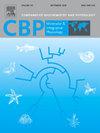使用兽医护理点装置评估野生斯温森画眉(Catharus ustulatus)在不同换羽阶段的代谢物谱。
IF 2.2
3区 生物学
Q4 BIOCHEMISTRY & MOLECULAR BIOLOGY
Comparative Biochemistry and Physiology A-Molecular & Integrative Physiology
Pub Date : 2025-07-28
DOI:10.1016/j.cbpa.2025.111912
引用次数: 0
摘要
迁徙和换毛都需要消耗大量的能量,而且生理需求相互冲突,因此通常会在时间上分开。在某些物种中,个体可能会在繁殖地之外的离散中转站(即换羽迁徙)中断换羽的迁徙,导致对换羽和迁徙的生理需求相互竞争,因为羽毛再生和有效迁徙都需要蛋白质。在这里,我们检查换羽和换羽后候鸟之间的血浆代谢物谱,通过使用现场实时数据的即时分析仪。换羽后鸟类的迁徙中途停留时间较短,其天冬氨酸转氨酶、钙、钠、磷和总蛋白的浓度显著高于换羽后鸟类,这与换羽过程中较高的代谢需求和换羽过程中羽毛再生导致的蛋白质耗损是一致的。此外,尿酸、肌酸激酶、总蛋白、天冬氨酸转氨酶和钾——所有这些都表明蛋白质分解代谢、肌肉损伤和脱水——在体重较轻的鸟类(低于7-7.5的比例质量指数)中较高,而与蜕皮状态无关,这与反映营养压力的较低能量储备一致。总之,这些代谢物谱是在一个捆绑站原位测量的,提供了实时的洞察,了解鸟类如何减轻在城市近郊中途停留时换羽和迁徙的生理竞争需求。本文章由计算机程序翻译,如有差异,请以英文原文为准。

Assessing metabolite profiles of wild Swainson's thrushes (Catharus ustulatus) in different moult stages using a veterinary point of care device
Migration and moult are both energetically demanding and have conflicting physiological requirements, therefore usually separated in time. In some species, individuals may interrupt their migration to moult at discrete stopover locations outside of their breeding grounds (i.e., moult-migration) leading to competing physiological demands for moult and migration as protein is needed both for feather regeneration and efficient migration. Here, we examine the plasma metabolite profiles between moulting and post-moulting migrants by using a point-of-care analyzer providing real-time data in the field. Post-moulting birds, who were on shorter migration stopovers, had significantly higher concentrations of aspartate aminotransferase, calcium, sodium, phosphorous, and total protein than moulting birds, which is consistent with higher metabolic demands during migration and depletion of protein due to feather regeneration during moult. Additionally, uric acid, creatine kinase, total protein, aspartate aminotransferase, and potassium – all indicative of protein catabolism, muscle damage, and dehydration – were higher in lighter birds (below a scaled mass index of 7–7.5) regardless of moult status, which is consistent with lower energy reserves reflecting nutritional stress. Together, these metabolite profiles, measured in situ at a banding station, provide real-time insight into how birds mitigate the physiologically competing demands of moult and migration at a peri-urban stopover.
求助全文
通过发布文献求助,成功后即可免费获取论文全文。
去求助
来源期刊
CiteScore
5.00
自引率
4.30%
发文量
155
审稿时长
3 months
期刊介绍:
Part A: Molecular & Integrative Physiology of Comparative Biochemistry and Physiology. This journal covers molecular, cellular, integrative, and ecological physiology. Topics include bioenergetics, circulation, development, excretion, ion regulation, endocrinology, neurobiology, nutrition, respiration, and thermal biology. Study on regulatory mechanisms at any level of organization such as signal transduction and cellular interaction and control of behavior are also published.

 求助内容:
求助内容: 应助结果提醒方式:
应助结果提醒方式:


